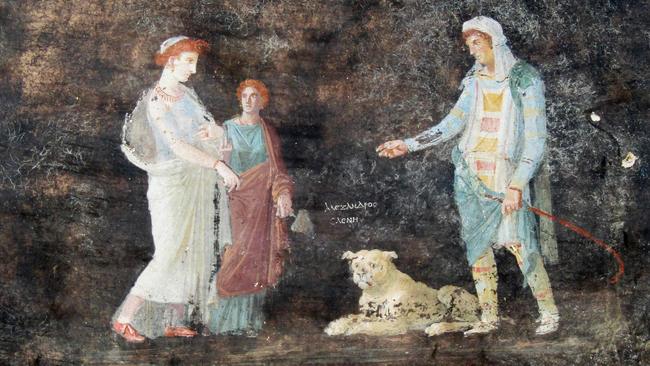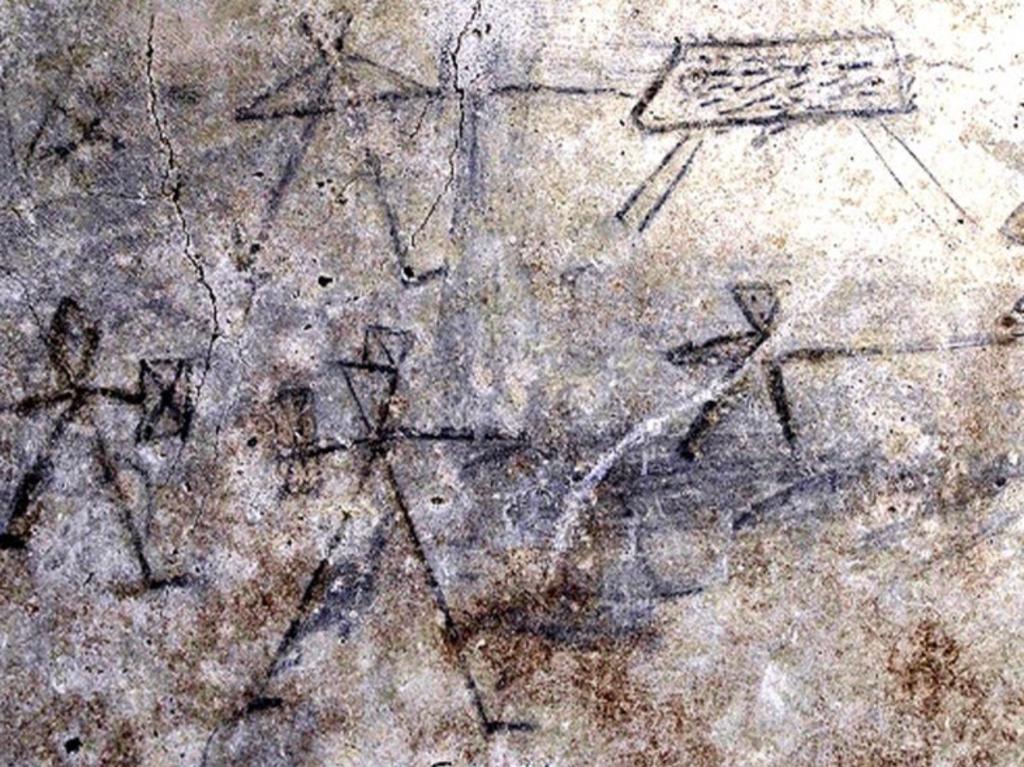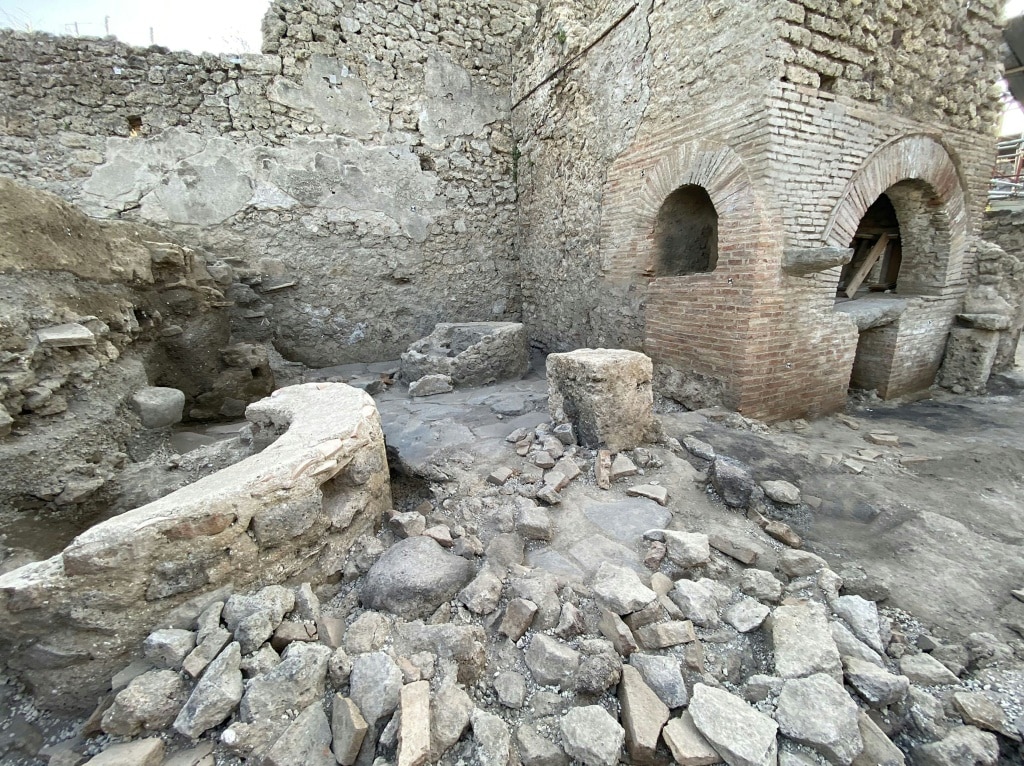Pompeii’s frescoes show the regional town boasted some high quality art
Recently discovered frescoes depicting scenes from Greek mythology highlight the skills of regional masters commissioned to paint them.

Unlike ancient sculpture, which survives either in originals or in the many copies made for the houses and gardens of wealthy Romans, the painting of antiquity has mostly been lost. No doubt many copies of the most famous masterpieces were similarly made for rich collectors throughout the empire; but although fresco is an extremely durable medium, it cannot outlast the walls on which it is painted, and as temples, public buildings, houses and villas were destroyed or fell into ruin through neglect, a whole history of painting disappeared with them.
A great deal of imagery, of course, survives in painted vases, which are breakable but not perishable, and in mosaics. Some mosaics, like the great battle of Alexander and Darius in Naples, may be based on lost painted masterpieces, but generally both of these media belong to different traditions from fresco painting and serve different decorative and design purposes, inherent to the nature of their media.
The question of ancient painting in what we might consider the high art category is particularly tantalising, because it is evoked in so many surviving literary sources. These are of two kinds. The first is a group of “ekphrastic” texts, writings that either are or purport to be descriptions of painted works; that is some are no doubt based on real pictures, while others are probably literary exercises in the vivid evocation of imaginary paintings. Fictional ekphrasis plays an important role in many ancient epics and novels, from Homer and Virgil to Moschus and Achilles Tatius. Ekphrases of real or imaginary works are found in prose authors such as Lucian and Philostratus.
The other category of ancient writing about art comprises biographical or anecdotal sources about celebrated painters and their works. The most important of these is the Roman author Pliny the Elder, in books 34-36 of his encyclopaedic Naturalis historia. His anecdotes about great artists such as Zeuxis, Apelles and others, as well as his brief accounts of some of their masterpieces, had an incalculable effect on Renaissance art writing and theory, and even on the behaviour of artists and patrons.
At the same time, modern artists and authors were left tantalised by Pliny’s evocation of long-lost works, as though all we knew of Michelangelo were a few anecdotes about his relationship with Pope Julius II and passing allusions to the Sistine ceiling and other masterpieces. Modern art is full of examples of works inspired by these elusive descriptions, like David’s painting of Brutus when the bodies of his dead sons are brought in, the sons he himself had put to death for conspiring against the republic: as Timanthes had displayed the grief of others at the sacrifice of Iphigeneia, but veiled the head of her father Agamemnon, leaving the viewer to imagine a suffering that was beyond representation, so David shows Brutus’ wife and daughters overcome by emotion, while he himself sits imperturbable but in deep shadow.
Some ancient paintings have been found intact over the centuries, and some landscapes from the Golden House of Nero, now lost, probably inspired those of Polidoro da Caravaggio in the little church of San Silvestro al Quirinale in Rome.
In recent years, some frescoes have been found at Vergina in Macedonia, including an impressively vivid image of Hades carrying off Persephone in his chariot. By far the largest collection of ancient frescoes has come to light in the excavations of Pompeii, starting in the latter part of the 18th century.
But there is something tantalising about the art of Pompeii, too. It is rather as though we only knew the great art of the Italian renaissance from the chance survival of one regional town in the peninsula; not Florence, Rome or Venice or any of the main centres, but a place where most of the work was done by artists who reproduced the styles of the great masters with varying degrees of success for wealthy regional patrons. It might have been very different if the eruption of Vesuvius had preserved a collection of villas from the glamorous resort town of Baiae, just a few kilometres away.
So not all the frescoes from Pompeii are masterpieces, or give an adequate idea of the highest achievement of ancient painting, but there are nonetheless many beautiful and refined works, which can today mostly be seen at the National Archaeological Museum in Naples, although a few, like the fascinating ensemble at the Villa of the Mysteries, have been preserved in their original locations.

The quality of the best frescoes shows that patrons in the city were able to commission prominent and highly-skilled painters, perhaps even artists who also worked in the millionaires’ villas on the nearby Bay of Naples. Discoveries continue to be made, however, including some that have just been made public in the past few weeks; and some of these recent discoveries are among the finest to come to light, particularly notable for the refinement of their sensibility and expression.
The first of these recently found works is a fresco of Leda and the Swan, found at the end of 2018 in what is now known as the House of Leda. This was a popular subject in Pompeian art, and incidentally one of the few mythological stories that fascinated both Leonardo da Vinci and Michelangelo fifteen centuries later. Leda was the daughter of King Tyndareus of Sparta, and Zeus is shown here coupling with her in the form of a swan while she meets the viewer’s eye with a direct yet slightly abashed gaze. From this union and a subsequent one with her husband, she would give birth to two eggs, containing Helen of Troy, the most beautiful woman in the world, Clytemnestra, the future wife of Agamemnon, and the twins Castor and Polydeuces (or Pollux), who later became the constellation Gemini.
As recently as March this year, another discovery was announced in the same house: this time a fresco of Phrixus and Helle, a story little-known today although it sets the scene for one of the most famous of all ancient myths.
Phrixus and his twin sister Helle were the children of Athamas, but their jealous stepmother Ino, daughter of Cadmus, plotted to murder them; they were miraculously saved by a flying golden ram who carried them on his back to the east, far from danger. As they crossed the Dardanelles, however, Helle slipped and fell, drowning in the sea that ever since has been called the Hellespont in her memory. Phrixus was carried by the ram all the way to the eastern shore of the Black Sea, landing at Colchis in what is now Georgia; there he sacrificed the ram, and hung up its Golden Fleece in a sacred grove, guarded by a dragon, where later Jason would be sent to retrieve it, in the original and most memorable of all quest myths.
It is a very fine fresco, in a relatively loose and painterly style, vivid in narrative but with less expressive articulacy. The ram seems to skim the surface of the water, almost as though swimming, and Phrixus’ lower legs are actually underwater; this proximity enhances the pathos of Helle’s death: she is seen just under the surface of the water, reaching up for help, her hand almost touching her brother’s; yet he seems to stare into space, indifferent to what is happening to his sister, disconnected as though in a dream.
And then, just last month, another important new find was unveiled: a large dining-room with walls painted black but decorated with several narrative scenes from the story of the Trojan War which, as the Pompeii Archaeological Park’s director Gabriel Zuchtriegel has observed, would have stood out against their dark background and seemed almost animate by the flickering lamplight of a banquet.

The mythological scenes include once again Leda and the swan, only this time it is before their coupling; she holds the swan in her left arm and with her right draws a large purple curtain or drape across to conceal her shame.
In another group, her daughter, Helen, accompanied by a handmaid, stands opposite Paris, with whom her adulterous affair (she is already married to Menelaus, king of Sparta) leads to the Trojan War.
The scene presumably represents their first meeting when Paris, a Trojan prince, has come to Sparta on a diplomatic visit; he wears a Phrygian bonnet, carries a shepherd’s crook and is accompanied by a dog which is also an allusion to his occupation as a shepherd. It was while he was guarding his father’s flocks that he was asked to be the judge in a fateful beauty contest between Aphrodite, Athena and Hera, and he awarded the prize to Aphrodite after she bribed him with the promise of the most beautiful woman in the world.
The owner of the house was clearly highly literate and his culture is further implied by the fact that inscription identifying the figures is in Greek.
The treatment of expression is notable: Paris seems to take it for granted that he will win Helen, and merely extends his hand to her; she stares at him, smitten with desire through the manipulation of Aphrodite. The maid looks up at her, as though recognising what is happening; and the dog, whose expression has been described as “despondent” perhaps symbolises a recognition of the fateful and tragic consequences of their affair.
The other important figure group in the same room depicts Apollo standing, with his lyre, opposite the Trojan princess Cassandra, who appears to be seated on the sacred omphalos at Delphi. Apollo, who was a supporter of the Trojan side in the war, loved Cassandra and endowed her with the gift of prophecy; but when she still refused her sexual favours, he doomed her always to be disbelieved.
This scene is less a direct telling of the story than – as perhaps the other scene can also be understood – a kind of philosophical reflection. For what is most striking is the contrast in the sensitively depicted expression of the two figures.
Apollo looks at Cassandra directly, with equanimity and without emotion; Cassandra, on the other hand, sits in an attitude that has always signified melancholy, the head, heavy with thought, supported on her hand – as later in Duerer’s Melencolia or Rodin’s Thinker. Her expression is the most remarkable of all these paintings, evoking a deep sense of resigned sadness. It is not only that she sees the future, knows that it is inevitable yet understands that no-one will heed her warnings. If the previous painting is a meditation on fate and the way that human desires are merely instruments of its blind mechanical working, this one evokes the distance between the serene and detached divine mind, ultimately aloof from grief, and the profound sadness of humans, unable to rise above an inevitable cycle of suffering.
Pompeii, The newly-discovered frescos







To join the conversation, please log in. Don't have an account? Register
Join the conversation, you are commenting as Logout